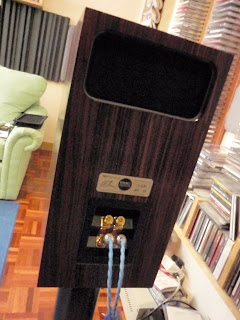 A close up of the PMC TB2i Signature. The dark and gorgeous Palissandre Rose veneer looks nicer by the day.
A close up of the PMC TB2i Signature. The dark and gorgeous Palissandre Rose veneer looks nicer by the day.The PMC TB2(the original, + and i) series speaker has been around for as long as I can remember. A buddy of mine was very happy with his find when he bought a pair of the original TB2 speakers in the used market. The recently re-issued TB2i Signature version looks very much like the latest i version, but with the following enhancements. First to greet your eye is the exclusive Palissandre Rose veneer, which at a glance, looks very much like the Tiger Wood veneer, but with much softer wood grain pattern. The other special treatments of the Signature series are largely heard and not seen, like the matched pair drivers and passive cross over components(which usually results in more balance L/R chanel volume matching resulting better separation and stability of imaging qualities within a sound stage). There's a small premium to the price of the PMC TB2i Signature at RM$7500.00/pair, which is not too expensive(over the regular i model).
 The PMC TB2i Signature with matching PMC stands, which are optional.
The PMC TB2i Signature with matching PMC stands, which are optional.AV Designs thought fully supplied me with a pair of matching PMC stands, which are optional at RM$1500.00/pair. The stands, which are partially sand filled, visually matches the TB2i Signature speakers well. Four sets of floor coupling spikes and coasters are supplied with each stand.
 View from the throne.
View from the throne.I assembled the stands and have the speakers attached to them with Blu-tac on four corners for stability. I tried to place the TB2i Signatures at various positions in my room, but it sounded best where my Fact 8 originally resides. I proceeded to level the floor coupling spikes and left it there for the rest of the review period.
 The PMC logo on the stands.
The PMC logo on the stands.As per my first experience with the original TB2 last year, which the latest Signature version bears all the same sonic hallmarks of, with a few areas refined. The mid centric tonal balance is still very much evident, but with much better refined highs and slightly improved extension. It gives a rather warmish and laidback impression to the musical performance. The punchy and rhythmic bass lines are still there but only this time it's tighter and cleaner note to note transfer. Compared to my floor standing Fact 8, the TB2i Signature rolls off at about 50Hz or so, naturally.
The TB2i Signature is also more transparent sounding than the original. It will play very loudly without strain and will certainly disappear in to the room completely. There's more space to it's imaging separation within the sound stage. Sound stage scale is nearly as big as my resident Fact 8, with comparable width and depth perception. Compared to the Fact 8 however, bandwidth is still limited, though improved over the original version. Most importantly, the TB2i Signature still proved every bit as musical as the original version.
 The TB2i uses PMC's proprietary ATL(Advance Transmission Line), it's rear facing port is on the top.
The TB2i uses PMC's proprietary ATL(Advance Transmission Line), it's rear facing port is on the top.For the asking price, it's hard to fault the PMC TB2i Signature's musical performance, even if it doesn't do spectacularly well in any particular hifi parameter, but rather it's a balanced all rounder of a performer, within it's design limits.

Peter Thomas signed, with special serial no. and the speakers are bi-wire able. The links can can replaced for better transparency.
PMC loudspeaker is sold by AV Designs, contact James, Tony at 03-21712828.
 Note the lock nut's position? On the left is bottom locking and on the right is top locking.
Note the lock nut's position? On the left is bottom locking and on the right is top locking.Some set up notes regarding the floor coupling speaker spikes, which is applicable with any floor standing, or stand mounted speakers that allows. The key to making a sonic difference with speakers in general is the placing of the locking nut of the spikes. There are two ways to do so.

First is to use the lock nuts from the top plate, which is usually my preferred method. I find that it is more practical as it is easier to manipulate the locking nut from the top, without the need to kneel and bow down to look for it. My big fat fingers also find it easier to just screw down the locking nut from the top. Sound wise, I find locking from the top usually gives the sound a slightly leaner and tighter presentation. Highs tend to be more exacting, although on some systems, it can mean a little dry too. Imaging tends to sharpened, or sound a little more forward and it's usually easier to focus the mouth of the vocalist, on closely miked recordings.

The second method is to lock from the bottom, which is the most commonly recommended. I find the sound to usually take on a freer, more laid back signature. The down side is that bass may become loose and bloated too!
Which method one chooses to use as floor coupling spike locking is largely influenced by owner preference and system balance. Neither is wrong or right, and best of all, this is a tweak that doesn't cost any $$$! It's also reverse able should one not like it, so there's really nothing to lose. Do try them out when time permits.
No comments:
Post a Comment